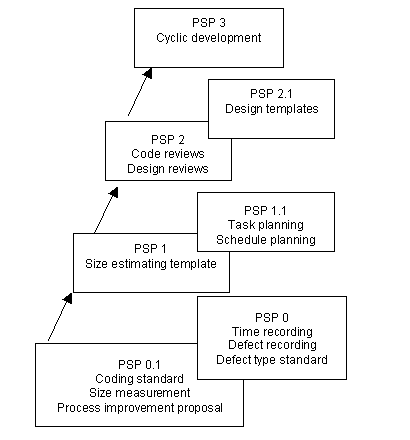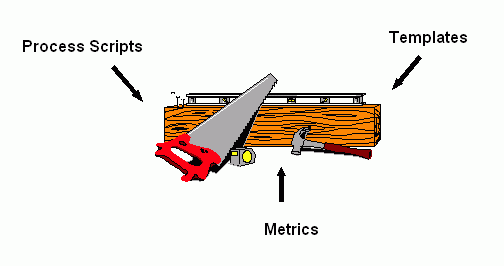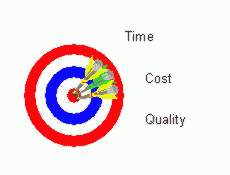Incorporating the Personal Software Process into the Rational Unified Process
by Harald Svensson
Ph.D. Student
Royal Institute of Technology
Stockholm, Sweden
Typically, there are three main factors important to the success of a software development project: time, cost, and quality (Figure 1). When we toss these three "darts," however, we often miss the bull's-eye, for a number of reasons.
In Sweden, one notable failure was a software project at the Swedish Patent and Registration Office, which contracted a large software development firm to implement a Web solution for companies to register themselves online with the Patent and Registration Office. The planned release was to be 1998 at an approximate cost of $15 million. But the system was actually delivered in September 2000, still incomplete, at a cost of $25 million.
|
Figure 1: Important Factors in Software Development Projects |
Why do projects fail? There have been many books and research articles on the subject, but it is safe to say that failure stems from both external and internal factors. An external factor, for example, might be that the product is already "old" and useless by the time it is developed; that is, it is based on out-of-date technology that makes the product cumbersome to use. Other possible external factors include key personnel leaving the project or customers changing the requirements specifications. These are all factors that you, as a software developer, cannot control.
One factor that you can control, however, is an internal one: the software development process. A defined and mature process usually results in good products. Furthermore, using such a process becomes more and more important as systems continue to grow in complexity and size.
Software Development Processes
Today, there are a number of software development processes: the Capability Maturity Model (CMM), the Rational Unified Process (RUP®), the Personal Software Process (PSP), and the Team Software Process (TSP), to name a few. Most of these processes focus on just one dimension regarding support for process improvement. The RUP and CMM, for example, provide support for software development at an organizational level; the TSP provides support at a team level; and the PSP provides it at an individual level.
Processes like the RUP and the TSP support teams and organizations to develop software but do not support the software processes of the individuals in the organizations. The focus and effort of coordinating work activities at a team level leaves out guidelines for the workers. As a consequence, it is more or less up to the individual worker to find ways to monitor, control, and improve his own personal software development process.
The Rational Unified Process (RUP)
The RUP defines process elements such as workers, activities, and artifacts that, when combined properly, will help an organization conduct a software project efficiently. The process itself, however, does not provide any magical solutions. It is the workers -- actual human beings -- who are the driving force of the project. Without human participants, no process or tool in the world could alone finish a software project. The end results -- whether the project finished on time and whether the released system was of high quality -- depend to a great extent on the quality of participants' individual software processes.
The RUP provides a knowledge base of information that helps workers do a better job. It differs from the approach used in the PSP, however, which provides the software engineer with more explicit support. Instead, the RUP provides a framework for how, what, when, and by whom various activities should take place in order to get a satisfying result. In other words, an organization using RUP will do well if it has competent and experienced people -- and will certainly do better than an organization with incompetent and inexperienced employees that attempts to use the RUP. It is always important for organizations with inexperienced people to quickly improve their employees' skills in order to save time and money. The RUP does not provide an answer to this issue of employee competence.
The Personal Software Process (PSP)
The PSP, in contrast, does address this employee improvement issue. The PSP is a framework for software process improvement for the individual software engineer. Watts Humphrey at the Software Engineering Institute (SEI) in Pittsburgh, Pennsylvania, developed it in 1995. The PSP provides metrics, process-steps, and templates that help an engineer improve her software engineering skills. Research results indicate significant process improvements among software engineers applying the PSP. Factors like productivity, number of injected defects, and time and size estimations tend to improve when the PSP is applied.
Figure 2 shows the PSP's process maturity levels. PSP0 is the most basic level, enabling the software engineer to establish a ground floor development process, whereas PSP3 is the most complex, with a number of metrics and templates available to the software engineer.

Figure 2: The PSP's Process Maturity Levels
How the PSP Can Support the RUP
In light of these positive results from applying the PSP, we might assume that similar process improvement awareness in the RUP would help workers improve their own processes, thereby enhancing the results of an organization as a whole. If you study and compare the PSP with the RUP, it becomes obvious that the PSP has process improvement concepts that can be applied in the RUP.
The main advantages of incorporating the PSP into the RUP are as follows:
- Task and schedule planning template. The RUP provides limited support to team members on how to manage work within an iteration. In the RUP, iterations can last for weeks or months. The project manager (or other lead) assigns tasks and responsibilities to project participants. It is up to the individual worker, however, to plan his work during the iteration. The RUP does not provide any support for this. The PSP, in contrast, provides task and schedule planning templates to monitor project progress. With these tools, software engineers can track their progress and know when they are slipping behind schedule. They can then inform the project manager about this status so that appropriate corrective actions can be taken.
- Checklists based on personal defect data. The workers in the RUP do not perform reviews based on personal defect data. Rather, they have checklists based on the most typical defect types collected in the organization. As a consequence, software engineers could be looking for defect types they never inject. The PSP, on the other hand, has checklists that are based on personal defect data. So software engineers will be looking for defect types they usually inject.
- Templates to record ideas for, and help move toward,
process improvement.
The RUP does not provide templates for writing down ideas for process improvement, but the PSP does provides templates for software engineers to record ideas as well as tasks to perform later on in the project. - Metrics to help improve process. The RUP does not provide predefined metrics that software engineers can use to monitor and control their software processes. Before each new project, metrics must be defined and explained to all project participants. There is no guarantee, however, that the defined metrics offer the kind of information a software engineer wants or needs in order to monitor his software development process. In these cases, it is up to the software engineer to define and apply appropriate metrics. The PSP, in contrast, has a number of metrics that provide information on improving the personal software development process.
Unfortunately, the PSP material cannot be applied directly by workers using RUP; it must be modified so that it suits the RUP context. If every RUP project were conducted in the same manner -- that is, if all artifacts, activities, workflows, lifecycle models, and so on, never changed -- then the PSP material would only need to be adapted once. This is not the case, however. Every project is unique and needs to be conducted in a particular way in order to be successful. This means that the RUP material -- activities, artifacts, and workflows -- must be modified and defined for the particular project at hand.
PSP Toolboxes for RUP Personnel
To address the opportunity to support the RUP with the PSP, we defined "PSP Toolboxes" for workers whose tasks are part of both processes: those who do design, code, and test activities. The toolboxes contain process scripts, templates, and metrics (see Figure 3) for workers using the RUP to apply, enabling them to analyze and control their software development processes.

Figure 3: A PSP Toolbox with Process Improvement Elements for Workers Using the RUP
We designed unique PSP Toolboxes for each of five workers defined in the RUP: Implementer, Integrator, Test Designer, Tester, and Designer. They all work in PSP-related activities and, furthermore, they were perceived as the main candidates for applying the PSP material. There are other workers in the RUP who also work with PSP activities, but to a lesser degree. For example, the Capsule Designer deals with concurrency issues, and can be viewed as a narrower version of the Designer. As a consequence, the work was restricted to defining PSP Toolboxes for the main worker categories mentioned above. It should be noted, however, that every worker in RUP ought to have a process improvement framework of his own, specially defined for that individual worker's needs and work environment. As the saying goes, however, that is another story; we will not address that issue here.
Incorporating the PSP into the RUP
So far so good. We have defined PSP Toolboxes for five chosen workers, and the material in those Toolboxes helps the workers monitor and control their software development processes. Two things, however, are still missing. First, a new process -- in this case the PSP -- should be introduced into an organization in a proper way. Experience tells us that the general guidelines presented in Table 1 are effective for process introductions.
Table 1: Guidelines for Introducing a New Process into an Organization
|
Guideline |
Comments |
|
Involve the right people |
Competent people with decision power and interest in the new process should be involved. |
|
Document new routines |
Decide who will do what and when. The documents can be used as references if questions arise. |
|
Demand feedback |
Responsible people should solicit critiques and suggestions as the new process is introduced. The people applying the new process should feel that they can affect important decisions related to the introduction. |
|
Conduct post-mortem analyses |
At each stage of the introduction, stop and evaluate. Continuously try to improve the adaptation of the new process. |
Second, the material in the PSP Toolboxes needs to be adapted and adjusted for each individual project. For instance, size metrics should be defined for software development projects, so that team members can measure the size of the products and estimate time and effort. It is impossible to know beforehand, however, whether the worker in question will apply, for example, Lines Of Code (LOC) or Function Points (FP), to name just two size metrics. The choice of metric may depend on the type of application developed or the tool used in the development effort. In addition, it is also impossible to know beforehand if the worker in question will count physical or logical lines if LOC is used, or what kinds of factors and weights he or she will choose if FP is used. As this small example illustrates, for any project, the people actually using the PSP Toolboxes should be the ones who adapt the contents in those toolboxes.
As Table 2 shows, the RUP does provide a number of guidelines to consider when adapting the RUP to a new project.
Table 2: RUP Guidelines to Consider When Adapting the RUP for a New Project
|
RUP Guideline |
Comments |
|
Analyze project and organization |
Analyze the type of application to be developed, size of the project, and organizational factors. |
|
Define scope of project |
Define the workflows to be used in the project; decide which tools will be used. |
|
Describe iteration plans |
Decide activities and their order of application in the iterations. The process should be defined thoroughly. |
|
Update the project's processes |
Evaluate the RUP after each iteration. |
In order to adapt the PSP to fit nicely with the RUP, it makes sense to consider the factors listed in Table 2 for both processes. That way, when you prepare for a new project, both the PSP and the RUP will be reviewed in the same areas and documented in a similar way, thereby easing the incorporation of the PSP into the RUP.
For each of the factors listed in Table 2, Table 3 shows corresponding guidelines for adapting the PSP Toolboxes to the RUP.
Table 3: Guidelines
for Adapting PSP Toolboxes to the RUP
(PSP guidelines in italics)
|
Guideline |
Comments |
|
Analyze project and organization |
Analyze the type of application to be developed. |
|
Define scope of project |
Define the workflows to be used in the project;
decide which tools will be used. |
|
Describe iteration plans |
Decide activities and their order of application in the iterations. The process should be defined thoroughly. |
|
Update the project's processes |
Evaluate the RUP after each iteration. |
The Process Engineer is the worker in RUP responsible for adapting the RUP to a new project, that is, to define a development case. The workers in RUP that will apply the PSP-toolboxes should thus work with the Process Engineer so that the PSP-elements will be adapted to the development case.
Advantages of Using the PSP with the RUP
The main advantages of supporting the RUP with the PSP are presented in Table 4. Maybe the most important advantage that the PSP provides is the drive for personal excellence. The PSP stresses that personal commitment and excellence are factors that have a major impact on process improvement results. Software engineers should always strive to do the best they can. That way, they will never be disappointed with respect to their efforts. Employees with this kind of commitment always outperform those who do not care about their work results, as long as the paychecks keep coming. The PSP helps people strive for personal excellence.
Table 4: The Main Advantages of Supporting the RUP with the PSP
|
Advantages of supporting the RUP with the PSP |
Comments |
|
Reduced number of defects in work products |
Reviews are based on personal defect data. |
|
Quantitative measures for the software development process |
Support through templates and metrics provides better control of the software development process. |
|
More accurate and precise estimates |
Estimates are based on personal process data. |
|
Striving for personal excellence |
The PSP helps people strive for improvement in their work routines. |
|
Better planning and control in the iterations |
The PSP provides control and planning for short time periods, an ideal complement to the RUP's iterations, which tend to have longer timeframes. |
It is important to remember that the software development process should provide support for all levels of work: for individuals as well as teams and organizations. The purpose of having defined processes is to ensure that the work ahead can be performed with a reasonably high degree of quality. "A chain is only as strong as its weakest link," as the saying goes. A project depends on the individuals involved in it, and these individuals, therefore, should have maximum support for improving their work routines. This is where the PSP can enhance the RUP.
1See:
Hayes, W. and Over, J.W. "The Personal Software Process (PSP): An Empirical Study of the Impact of the PSP on Individual Engineers." Technical Report, CMU/SEI-97-TR-001, ESC-TR-97-001, Software Engineering Institute, December 1997.
Humphrey, W. A Discipline for Software Engineering. Addison-Wesley Publishing Company. 1997.
Stavros, K. M. and Avratoglou , Dr C. "Personal Software Process Implementation in a Production Environment." EuroSPI98, Gothenburgh, Sweden, 1998.
![]()
For more information on the products or services discussed in this article, please click here and follow the instructions provided. Thank you!
